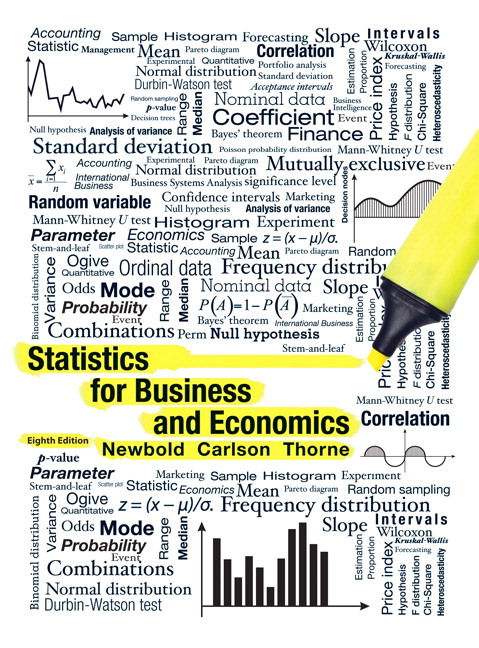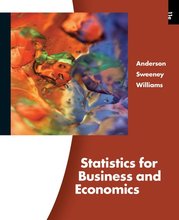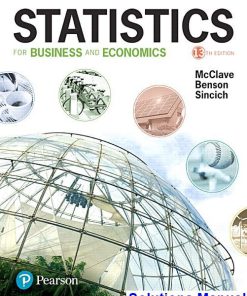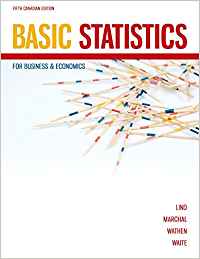Solution Manual for Statistics for Business and Economics 8th Edition by Newbold
$35.00 Original price was: $35.00.$26.50Current price is: $26.50.
Solution Manual for Statistics for Business and Economics 8th Edition by Newbold
Instant download Solution Manual for Statistics for Business and Economics 8th Edition by Newbold pdf docx epub after payment.

Product details:
- ISBN-10 : 0132745658
- ISBN-13 : 978-0132745659
- Author: William Carlson (Author), Betty Thorne (Author), Paul Newbold (Author)
Statistics for Business and Economics enables readers to conduct serious analysis of applied problems rather than running simple “canned” applications. This text is also at a mathematically higher level than most business statistics texts and provides readers with the knowledge they need to become stronger analysts for future managerial positions.
The eighth edition of this book has been revised and updated to provide readers with improved problem contexts for learning how statistical methods can improve their analysis and understanding of business and economics.
Additional business examples have been added in the chapter-opener and throughout the chapter
Table of contents:
- CHAPTER 1 Describing Data: Graphical
- 1.1 Decision Making in an Uncertain Environment
- Random and Systematic Sampling
- Sampling and Nonsampling Errors
- 1.2 Classification of Variables
- Categorical and Numerical Variables
- Measurement Levels
- 1.3 Graphs to Describe Categorical Variables
- Tables and Charts
- Cross Tables
- Pie Charts
- Pareto Diagrams
- 1.4 Graphs to Describe Time-Series Data
- 1.5 Graphs to Describe Numerical Variables
- Frequency Distributions
- Histograms and Ogives
- Shape of a Distribution
- Stem-and-Leaf Displays
- Scatter Plots
- 1.6 Data Presentation Errors
- Misleading Histograms
- Misleading Time-Series Plots
- CHAPTER 2 Describing Data: Numerical
- 2.1 Measures of Central Tendency and Location
- Mean, Median, and Mode
- Shape of a Distribution
- Geometric Mean
- Percentiles and Quartiles
- 2.2 Measures of Variability
- Range and Interquartile Range
- Box-and-Whisker Plots
- Variance and Standard Deviation
- Coefficient of Variation
- Chebyshev’s Theorem and the Empirical Rule
- z-Score
- 2.3 Weighted Mean and Measures of Grouped Data
- 2.4 Measures of Relationships Between Variables
- Case Study: Mortgage Portfolio
- CHAPTER 3 Probability
- 3.1 Random Experiment, Outcomes, and Events
- 3.2 Probability and Its Postulates
- Classical Probability
- Permutations and Combinations
- Relative Frequency
- Subjective Probability
- 3.3 Probability Rules
- Conditional Probability
- Statistical Independence
- 3.4 Bivariate Probabilities
- Odds
- Overinvolvement Ratios
- 3.5 Bayes’ Theorem
- Subjective Probabilities in Management Decision Making
- CHAPTER 4 Discrete Random Variables and Probability Distributions
- 4.1 Random Variables
- 4.2 Probability Distributions for Discrete Random Variables
- 4.3 Properties of Discrete Random Variables
- Expected Value of a Discrete Random Variable
- Variance of a Discrete Random Variable
- Mean and Variance of Linear Functions of a Random Variable
- 4.4 Binomial Distribution
- Developing the Binomial Distribution
- 4.5 Poisson Distribution
- Poisson Approximation to the Binomial Distribution
- Comparison of the Poisson and Binomial Distributions
- 4.6 Hypergeometric Distribution
- 4.7 Jointly Distributed Discrete Random Variables
- Conditional Mean and Variance
- Computer Applications
- Linear Functions of Random Variables
- Covariance
- Correlation
- Portfolio Analysis
- CHAPTER 5 Continuous Random Variables and Probability Distributions
- 5.1 Continuous Random Variables
- The Uniform Distribution
- 5.2 Expectations for Continuous Random Variables
- 5.3 The Normal Distribution
- Normal Probability Plots
- 5.4 Normal Distribution Approximation for Binomial Distribution
- Proportion Random Variable
- 5.5 The Exponential Distribution
- 5.6 Jointly Distributed Continuous Random Variables
- Linear Combinations of Random Variables
- Financial Investment Portfolios
- Cautions Concerning Finance Models
- CHAPTER 6 Sampling and Sampling Distributions
- 6.1 Sampling from a Population
- Development of a Sampling Distribution
- 6.2 Sampling Distributions of Sample Means
- Central Limit Theorem
- Monte Carlo Simulations: Central Limit Theorem
- Acceptance Intervals
- 6.3 Sampling Distributions of Sample Proportions
- 6.4 Sampling Distributions of Sample Variances
- CHAPTER 7 Estimation: Single Population
- 7.1 Properties of Point Estimators
- Unbiased
- Most Efficient
- 7.2 Confidence Interval Estimation for the Mean of a Normal Distribution: Population Variance Known
- Intervals Based on the Normal Distribution
- Reducing Margin of Error
- 7.3 Confidence Interval Estimation for the Mean of a Normal Distribution: Population Variance Unknow
- Student’s t Distribution
- Intervals Based on the Student’s t Distribution
- 7.4 Confidence Interval Estimation for Population Proportion (Large Samples)
- 7.5 Confidence Interval Estimation for the Variance of a Normal Distribution
- 7.6 Confidence Interval Estimation: Finite Populations
- Population Mean and Population Total
- Population Proportion
- 7.7 Sample-Size Determination: Large Populations
- Mean of a Normally Distributed Population, Known Population Variance
- Population Proportion
- 7.8 Sample-Size Determination: Finite Populations
- Sample Sizes for Simple Random Sampling: Estimation of the Population Mean or Total
- Sample Sizes for Simple Random Sampling: Estimation of Population Proportion
- CHAPTER 8 Estimation: Additional Topics
- 8.1 Confidence Interval Estimation of the Difference Between Two Normal Population Means: Dependent
- 8.2 Confidence Interval Estimation of the Difference Between Two Normal Population Means: Independen
- Two Means, Independent Samples, and Known Population Variances
- Two Means, Independent Samples, and Unknown Population Variances Assumed to Be Equal
- Two Means, Independent Samples, and Unknown Population Variances Not Assumed to Be Equal
- 8.3 Confidence Interval Estimation of the Difference Between Two Population Proportions (Large Sampl
- CHAPTER 9 Hypothesis Testing: Single Population
- 9.1 Concepts of Hypothesis Testing
- 9.2 Tests of the Mean of a Normal Distribution: Population Variance Known
- p-Value
- Two-Sided Alternative Hypothesis
- 9.3 Tests of the Mean of a Normal Distribution: Population Variance Unknown
- 9.4 Tests of the Population Proportion (Large Samples)
- 9.5 Assessing the Power of a Test
- Tests of the Mean of a Normal Distribution: Population Variance Known
- Power of Population Proportion Tests (Large Samples)
- 9.6 Tests of the Variance of a Normal Distribution
- CHAPTER 10 Hypothesis Testing: Additional Topics
- 10.1 Tests of the Difference Between Two Normal Population Means: Dependent Samples
- Two Means, Matched Pairs
- 10.2 Tests of the Difference Between Two Normal Population Means: Independent Samples
- Two Means, Independent Samples, Known Population Variances
- Two Means, Independent Samples, Unknown Population Variances Assumed to Be Equal
- Two Means, Independent Samples, Unknown Population Variances Not Assumed to Be Equal
- 10.3 Tests of the Difference Between Two Population Proportions (Large Samples)
- 10.4 Tests of the Equality of the Variances Between Two Normally Distributed Populations
- 10.5 Some Comments on Hypothesis Testing
People also search:
Statistics for Business and Economics 8th Edition
Statistics for Business and Economics 8th Edition
Statistics for Business and Economics 8th Edition pdf
what is statistics for business and economics
|
statistics for economics accounting and business studies
|
You may also like…
Solution Manual












